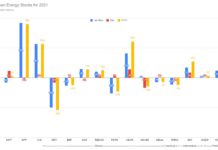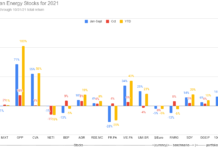I never thought 2009 would be a good year for risky stocks, but my readers asked for them anyway. The market’s strong third quarter have paid off for risk-takers who gambled on my 10 Green Energy Gambles for 2009.
I started out the year by providing readers with a portfolio of ten relatively conservative plays on green energy. That portfolio was representative of how I planned to approach the market this year, and has produced stronger returns and less volatility when compared to both green energy stocks and the market as a whole. Many of my readers are looking for big gains on little stocks, so I also provided (but did not endorse) ten such green energy gambles.
I went into some detail on each, but I generally felt that most of those stocks would benefit disproportionately from an easing of the credit crunch. In Q1 and Q2, those gambles performed in-line with the green energy sector indexes, but the return of optimism in the third quarter has allowed these risky stocks to shoot ahead of the sector with the turbo-charged performance that I hoped they would provide. They’ve even managed to pull ahead of my extremely strong conservative portfolio (by 44% to 41%.)
If the fourth quarter is anything like the third, I’d expect the portfolio to end the year with a double. I don’t expect that to happen, but I’ve been wrong about the length of this rally before.
The following table and graph show stock-by-stock performance for the first three quarters:
| Ticker | 1/9/09 close | 4/9/09 close | 7/13/09 close | 10/8/09 close |
Gains 1/9 to 10/8/09 |
| BCON | $0.46 | $0.47 | $0.637 | $0.686 | 49% |
| AXPW.OB | $1.20 | $0.85 | $1.34 | $2.14 | 78% |
| VLNC | $1.77 | $2.23 | $1.51 | $1.60 | -10% |
| CPTC.OB | $0.30 | $0.23 | $0.245 | $0.489 | 63% |
| EPG | $0.86 | $0.34 | $0.54 | $0.44 | -49% |
| EMKR | $1.43 | $0.84 | $1.07 | $1.32 | -8% |
| UQM | $1.72 | $1.70 | $2.46 | $5.97 | 247% |
| CZZ | $4.18 | $4.45 | $5.00 | $7.91 | 89% |
| RZ | $3.62 | $4.13 | $2.00 | $1.46 | -60% |
| ZOLT | $7.47 | $7.98 | $8.46 | $10.62 | 42% |
| Portfolio | $1,000 | $900.20 | $986 | $1443 | 44% |
|
Benchmarks |
|||||
| ICLN | $21.93 | $19.40 | $21.01 | $23.08 | 5% |
| PBW | $9.01 | $8.55 | $9.15 | $10.81 | 20% |

Benchmarks
The two benchmarks, the iShares S&P Global Clean Energy Index ETF (ICLN) and the PowerShares Clean Energy Index ETF (PBW) most likely produced such different results because
- US-based clean energy companies received more of a boost from the ARRA or stimulus package than global firms
- The global firms in ICLN’s portfolio tend to be better established and more profitable than those in PBW’s portfolio, which means that ICLN will typically outperform PBW in down markets, and underperform in up markets. This is exactly what we have seen this year, with the best performance coming from ICLN in the dismal 1st quarter, but PBW gaining ground since then.
Compared to these two, the portfolio has done quite well. Even in t
he down first quarter, the highly volatile companies in the portfolio managed to perform better than the slightly more stable companies in PBW, but they were able to take off much faster than PBW when the market turned around.
Notes Individual Stocks
With the exception of Axion Power (AXPW.OB) and a small option position on Raser Technologies (RZ), I’ve sold my stake in all of these, and no longer follow them.
That said, the best place to go for information on the three energy storage stocks (Axion Power International (AXPW.OB), Beacon Power Corporation (BCON), and Valence Technology Inc (VLNC)) is John Petersen. He recently discussed how the stocks in the energy sector were performing here.
The best performer so far has been UQM Technologies (UQM). In January, I said "an auto bail-out which forced the big three to produce many more hybrid and electric vehicles could prove a bonanza for UQM." We had such an auto-bailout, but UQM’s success did not come solely from government stimulus. Rather, the stock began to take off when they announced a deal to supply drive trains for an electric sedan from Coda Automotive, and then accelerated when they received a $45m award of ARRA funds.

A similar story to UQM was my lone nod to biofuel, Brazilian ethanol producer Cosan, Ltd.(CZZ). I said, "Either a return to high oil prices, or a reduction in America’s ethanol import duty could greatly help the stock." Since then, there has been a lot of talk that the administration is considering ending ethanol import tariffs. The recent rise in oil prices also seems to be helping the stock.
My least successful bet has been Raser Technologies, Inc. (RZ). I began to think the stock had fallen far enough in my six month review of these stocks, and soon after called Raser "too cheap to ignore" with the idea that an announcement or government loan guarantees or other funding might cause the stock to take off, just as it did to UQM. A month later, the DOE denied the loan guarantees, and I sold my stake except for a few $5 calls (one of their ships may still come in.) I’m now even more bearish on Raser with the revelation that they were a bit overoptimistic about delivering power from low temperature geothermal sources. Fortunately, I got out with only a small loss.
I have not been watching Composite Technology Corp (CPTC.OB), Environmental Power Corp. (EPG), Zoltek (ZOLT), or Emcore Corp. (EMKR) since I sold them.
DISCLOSURE: Tom Konrad and/or his client have positions in AXPW and RZ.
DISCLAIMER: The information and trades provided here and in the comments are for informational purposes only and are not a solicitation to buy or sell any of these securities. Investing involves substantial risk and you should evaluate your own risk levels before you make any investment. Past results are not an indication of future performance. Please take the time to read the full disclaimer here.








While I haven’t read all of Petersen’s lengthy analyses, I frankly disagree with what appears to be his primary assumption about Beacon Power. What he says may be true if you buy the assumption that it’s an energy storage play competing with battery technologies, but that hasn’t been the case since, what, 2001?
Beacon’s market is utility grid frequency regulation. Yes, it performs that role unconventionally, by storing energy, but that’s where the parallels with chemical batteries end. It both stores and delivers that energy in a way that no chemical battery possibly could, with lightning response time and basically infinite cycling capability. As the grid gets smarter with more and varied inputs to it, that is a role desperately in need of being filled, and chemical batteries simply can’t do it sustainably, extra capacitors notwithstanding.
I don’t dispute Petersen’s credibility as far as his expertise goes in the battery market, but he needs to back off this misrepresentation of what Beacon is trying to do as it casts a cloud over the rest of what he’s saying. Whether Beacon’s tech is competitive is another question, but you can’t answer that question if you ask it incorrectly.
Redwood,
When I started following Beacon, I agreed with you, but I have since changed my mind.
Beacon’s technology does compete with batteries, especially Li-ion, which have very fast response time. If a battery is fast enough to respond to your foot on the accelerator of a hybrid car, it should be fast enough for most grid applications.
Beacon’s flywheels and capacitors are indeed faster than batteries, but is the extra speed really needed for frequency regulation.
Beacon still has an advantage of infinite cycle life, but if if batteries cost half as much and last 15 years, they will still have the advantage.
I, like you, don’t know if Beacon’s tech is competitive on its own terms, but it has to compete with batteries as well as gas turbines, and this is part of the reason I no longer own the company.
Redwood, the thing you need to understand about utility connected storage applications is that there is a continuum of needs that range from ultra-heavy duty frequency regulation at one extreme to diurnal storage at the other. As I told the audience at EESAT this last week, the market opportunities are endless and everybody that brings a product to market will have more demand than he can satisfy, but the idea that there is a single “best” technology for a broad class of applications is simply wrong.
There were detailed presentations at EESAT by both Beacon and the lithium-ion companies that are doing frequency regulation tests. There was no difference I could see between the signal following of the flywheel or battery systems, although in some cases the extra longevity of the flywheel systems will give them an edge and in others the greater energy of the battery systems will give them the edge. Heck, even Exide gave a presentation on its successful completion of a 12 year test on a lead-acid system that met all the frequency regulation and spinning reserve needs for an island off the coast of Alaska.
Overall, the grid markets are going to fall into a bell shaped curve like all other human endeavor. The far right hand tail of the curve will usually go to systems like the Beacon flywheels or the Altair and A123 battery packs. As you get closer to the middle of the curve, the options get far more numerous.
I like Beacon at current price levels and believe that they’ll have an easier time increasing energy than a battery system, but it would be wrong to assume that they have a lock on any particular market with no effective competition.